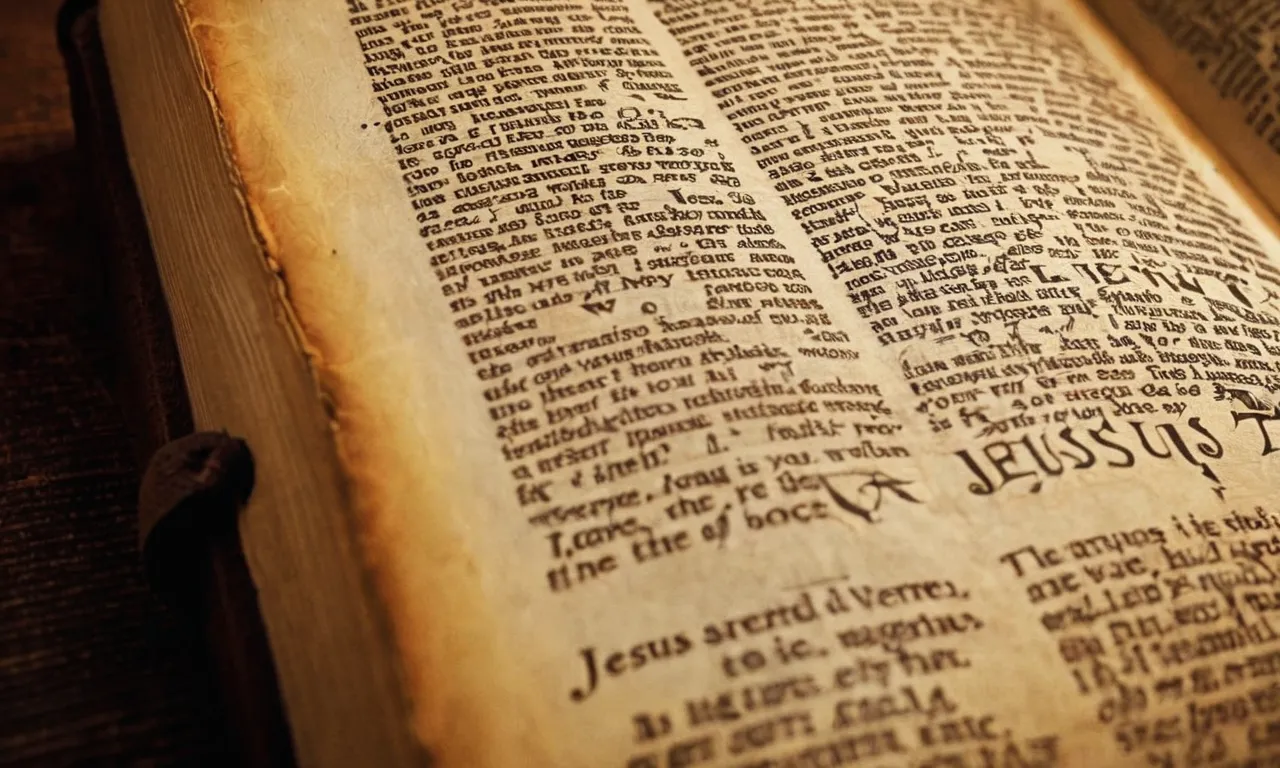How Many Times Did Jesus Rest In The Bible?
Rest is an important theme throughout the Bible, including in the life of Jesus. If you’re short on time, the quick answer is that there are five specific instances recorded in the Gospels where Jesus rested. But there’s more to explore about this topic that we’ll cover in this article.
We’ll take a deep dive into the times Jesus withdrew to rest and recharge, looking at the context, significance, and lessons we can learn. This article will provide a thorough examination of the scriptural accounts of Jesus resting.
The First Rest – After His Baptism
The Baptism of Jesus
Jesus commenced his public ministry when he was baptized by John the Baptist in the Jordan River. This symbolic act marked the beginning of Jesus’ mission to preach repentance and the coming of the Kingdom of God (Mark 1:9-11).
After Jesus rose from the waters, the Holy Spirit descended on him and God the Father declared, “You are my beloved Son; with you I am well pleased.” This divine affirmation equipped Jesus for his demanding work ahead.
Jesus’ Temptation in the Wilderness
Immediately after his baptism, Jesus was led by the Spirit into the Judean wilderness to be tempted by the devil for 40 days (Matthew 4:1-11). He ate nothing during this time and experienced acute hunger.
The evil one tried to entice Jesus to use his divine power for selfish gain – to turn stones into bread, to test God’s protection, and to worship Satan in exchange for authority. Jesus refused all these temptations by quoting Scripture.
He emerged victorious, but likely physically and emotionally drained.
Rest and Solitude After a Major Event
It was after these two intense, back-to-back episodes – Jesus’ baptism and temptation in the desert – that he rested. Mark 1:12 tells us, “The Spirit immediately drove him out into the wilderness.” Jesus retreated to process this defining moment in solitude with God. He needed time to pray, fast, replenish his soul, and prepare for the travel, teaching, and miracles ahead.
Retreating after milestone moments is a common biblical theme. After the Israelites miraculously crossed the Red Sea, they camped in isolation (Exodus 15:22-27). After Elijah defeated the prophets of Baal, he fled alone into the wilderness (1 Kings 19:1-8).
Jesus likewise recognized the human need for rest – to commune with God, process events, and renew strength of mind, body and spirit before continuing his Father’s work.
Retreating to the Mountains to Pray
Jesus often withdrew from the crowds and his disciples to spend time alone in prayer. Throughout the Gospels, there are several instances where Jesus retreated to the mountains or other solitary places to connect with God the Father and restore his spirit.
His habit of rising early to pray and withdrawing to lonely places, despite the heavy demands of his ministry, reminds us how important it was for Jesus to regularly retreat and recharge.
Jesus’ Habit of Rising Early to Pray
The Gospels specifically mention Jesus rising early in the morning, while it was still dark, to find a solitary place and pray. For example: “Very early in the morning, while it was still dark, Jesus got up, left the house and went off to a solitary place, where he prayed” (Mark 1:35).
This pattern is seen several times, showing it was a regular habit of Jesus to connect with God at the start of each day, replenishing himself through prayer before embarking on his demanding ministry schedule.
Withdrawing to Lonely Places
In addition to his daily habit of morning prayer, Jesus would frequently withdraw from both the crowds of people and even his closest disciples to pray alone. The Bible documents many instances where Jesus retreated by himself – often going to the mountains, as they afforded isolation from other people.
We read that “Jesus went out to a mountainside to pray, and spent the night praying to God” (Luke 6:12) and many other examples of him going off alone into the hills.
These lonely places – whether a mountain, the Garden of Gethsemane, the wilderness, or other isolated spots – provided space for Jesus to pour out his heart to God. The demands of his ministry were heavy, with nonstop crowds pursuing him, and Jesus needed to regularly withdraw to reconnect with his Heavenly Father and be renewed in the depths of his spirit.
The Demands of Jesus’ Ministry
Why did Jesus need to retreat so often for prayer and renewal, despite being the very Son of God? Although Jesus was divine, he was also fully human. The enormous demands of his ministry took an emotional, mental, physical and spiritual toll.
Consider this summary of a typical day for Jesus, compiled from the Gospels:
- Teaching/preaching to huge crowds, with thousands of eager yet needy people pressing in on him for healing or answers (Matthew 14:13-14)
- Personally ministering through delivering people from demons and disease (Mark 1:32-34)
- Praying intensely for hours at a time for others (Luke 6:12)
- Being constantly surrounded by crowds with little chance for rest (Mark 6:31)
- Facing critics, skeptics and enemies seeking to undermine or trap him (Luke 11:53-54)
In the face of these types of heavy burdens and pressures every day, no wonder Jesus needed to rise early to pray and periodically withdraw entirely! Retreat was essential for Jesus to be able to keep pouring himself out so completely in service of others.
| Type of Demand | Example from Jesus’ Ministry |
|---|---|
| Physical Demands | Little sleep, walking miles between towns, fasting for 40 days |
| Spiritual Warfare | Temptation by the devil, confrontation with demons |
| Emotional Burden | Weeping over Jerusalem, agonized prayer in Gethsemane |
| Relational Stress | Dealing with doubters and critics, betrayal |
Jesus did not retreat from work entirely – he remained extremely diligent in his ministry, sometimes even foregoing food and sleep (John 4:31, Luke 6:12). However, he modeled the importance of balancing work with spiritual retreat and renewal.
Just as sleep and nutrition are vital even amidst a busy life, so too connecting alone with God replenished Jesus’ weary soul. We would do well to follow his example.
The Third Rest – Sleeping Through a Storm
Crossing the Sea of Galilee
After an intense period of teaching and healing, Jesus and his disciples set off across the Sea of Galilee, also known as the Sea of Tiberias (John 6:1). This freshwater lake in northern Israel was home to a thriving fishing industry.
The disciples, many of whom were fishermen themselves, were accustomed to navigating its waters in their trade.
As they boarded a small fishing boat that fateful day, gathering clouds foreboded a storm. Undeterred, they embarked on their journey, the disciples plying their nautical skills, while Jesus settled down for some much-needed rest.
Jesus Calms the Storm
The Sea of Galilee was known for intense squalls that could whip up powerful winds and waves with little warning due to its unique location in the Jordan Rift Valley. True to form, as Jesus slept soundly in the stern, a furious tempest battered the helpless craft (Mark 4:37).
Despite their sailing expertise, the panicking disciples realized they were no match for the raging storm. In desperation, they woke Jesus with anxious cries to, “Teacher, do you not care if we drown?” (v.38).
In a beautiful demonstration of his divine power cloaked in human flesh, Jesus “got up, rebuked the wind and said to the waves, “Quiet! Be still!” Then the wind died down and it was completely calm” (v.39).
Standing amid shocked disciples with windswept clothes and salt-encrusted hair, Jesus asked, “Why are you so afraid? Do you still have no faith?” (v.40). Not only had Jesus calmed the violent storm, but he also calmed his followers’ troubled hearts that were tossed about in turmoil and disbelief.
The Humanity and Divinity of Jesus
This intriguing episode captures both Christ’s humanity and divinity concurrently on display. Jesus’ exhausted slumber reveals his human vulnerability. As fully God and fully human, Jesus knew what it meant to endure physical tiredness.
Contrary to some false teaching, he was not immune to normal biological needs or human limitations (Heb 2:17).
However, Jesus’ supernatural calming of the tempest proves his divine authority over the natural realm. As the Gospel writer rhetorically asks, “Who is this? Even the wind and the waves obey him!” (v.41). Creator, Sustainer and Savior – Jesus Christ is Lord over all creation.
Stilling the storm provided undeniable evidence to reinforce the disciples’ fledgling faith in him.
This miracle aptly represents Jesus’ power to quell the storms that rage in our inner lives as well. Just as Jesus rebuked the wind that threatened the disciples at sea, he is able to speak peace to the turmoil, anxiety and doubts that frequently toss our souls about.
As one commentator notes, “The God who controls the wind and waves can certainly handle any problem we bring to Him”.
Resting at Bethany Before the Triumphal Entry
The Raising of Lazarus
After Jesus raised Lazarus from the dead in Bethany, he continued to stay there for a while before his triumphal entry into Jerusalem (John 11:54). Bethany was about 2 miles east of Jerusalem, and Jesus likely stayed at the home of Lazarus, Martha, and Mary.
This miracle of raising Lazarus from the dead after four days in the tomb was the climax of Jesus’ public ministry before his passion week. It demonstrated Jesus’ power over death and caused many to believe in him (John 11:45).
However, it also provoked the anger of the chief priests and Pharisees who began to earnestly plot to kill Jesus (John 11:47-53). So this time in Bethany allowed Jesus to spend peaceful time with his friends Mary, Martha, and Lazarus after performing this momentous miracle.
Withdrawing to Ephraim
After raising Lazarus, John’s gospel says that Jesus withdrew with his disciples to the countryside near the wilderness, to a town called Ephraim. He stayed there with his disciples (John 11:54). Ephraim was located about 12-15 miles northeast of Jerusalem.
By withdrawing here, Jesus avoided the priests and Pharisees who were seeking to seize him after the uproar caused by the raising of Lazarus. So this time in Ephraim allowed Jesus some peaceful time with his disciples before facing his passion in Jerusalem.
It was likely a time of teaching and preparation for the disciples before Jesus’ triumphal entry and final week in Jerusalem.
Six Days Before Passover
The Synoptic Gospels state that Jesus arrived in Bethany six days before the Passover (Matthew 21:1, Mark 11:1, Luke 19:29). John 12:1 also mentions that Jesus came to Bethany six days before the Passover.
While John doesn’t specify when Jesus arrived here, it was likely after his stay in Ephraim mentioned in John 11. So Jesus returned to Bethany from Ephraim sometime shortly before his triumphal entry. He likely stayed in the home of Martha, Mary, and Lazarus again.
Bethany was close enough to go in and out of Jerusalem easily. Staying here allowed Jesus some peaceful time with friends as he prepared for the climactic events of Passion Week.
The Fifth Rest – Praying in Gethsemane
The Last Supper
The fifth time Jesus rested is described in the Gospel of Matthew during the Passion week, after celebrating the Last Supper with his disciples on the night before his crucifixion. The Last Supper is an important event where Jesus shared his final meal with his 12 disciples before his death and resurrection.
He foretold his betrayal by one of his disciples and instituted the Eucharist, also known as the Lord’s Supper or Communion (Matthew 26:26-29). This somber meal represented Jesus’ sacrificial death on behalf of humanity.
Jesus Prays in Agony
After the Last Supper, Jesus went with his disciples to the Garden of Gethsemane to pray. Despite the emotional weight of his impending death, Jesus selflessly prayed for God’s will to be done (Matthew 26:36-46). For the fifth time recorded in Scripture, Jesus rested and communed with God.
Although Jesus was fully divine, he was also fully human. He experienced the full range of human emotions, including sorrow and distress. In an amazing display of submission, Jesus surrendered his will to follow God’s plan for salvation.
The Gospel of Luke provides additional details, describing how Jesus prayed so fervently that his sweat became like drops of blood (Luke 22:39-46). The intense spiritual battle Jesus faced in Gethsemane highlights his humanity and obedience.
This was likely an excruciating experience both emotionally and physically for Jesus.
The Betrayal and Arrest
After time in prayer, Jesus’ disciple Judas arrived with soldiers to arrest him. This represented the betrayal Jesus foretold at the Last Supper. The soldiers took Jesus before the Sanhedrin and Pilate to be tried and crucified (Matthew 26:47-56).
Despite having the power as the Son of God, Jesus did not resist arrest. He remained obedient to God’s plan that he atone for the sins of mankind.
The time Jesus spent resting and praying in the Garden of Gethsemane reminds us of the very human side of Jesus. He understands human frailties and can empathize with our human struggles (Hebrews 4:15).
Jesus’ agony in prayer and willingness to be crucified for us demonstrates God’s incredible love and sacrifice (John 3:16).
Conclusion
In reviewing the accounts of Jesus’ life in the Gospels, we find five distinct occasions where he paused to rest and retreat from the demands of ministry. These incidents reveal Jesus’ humanity and dependence on the Father through prayer.
Although few in number, these rests were strategic moments that equipped Jesus for the ultimate purpose of his life – sacrificing himself on the cross for our salvation.
As followers of Christ, we can learn from Jesus’ example about the importance of rest, solitude, prayer, and proper preparation for the tasks God calls us to. May we strive to regularly withdraw from the hustle of life to be refreshed and renewed in God’s presence.








